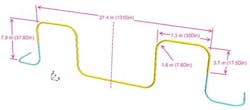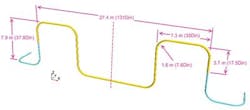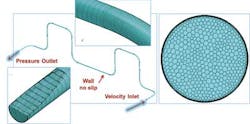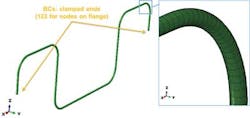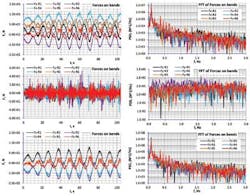Simulation helps assess fatigue life of subsea jumpers-full
Oleg Voronkov
Alan Mueller
Alex Read
Sabine Goodwin
CD-adapco
Structural vibrations of subsea piping systems stem from either external currents passing around the structure (vortex-induced vibration or VIV) or from transient flows of mixtures inside the pipes (flow-induced vibration or FIV). These vibrations compromise the structural integrity of subsea systems and in extreme circumstances can reduce their fatigue life from years to weeks.
The transient multi-phase flow inside subsea piping is complex and gaining insight through physical subsea measurements is expensive and challenging. As a result, the industry has relied on simple analysis methods to predict the effects of FIV. These approaches tend to be overly conservative, making the decision process concerning structural integrity of subsea piping systems difficult. This has had a significant economic impact as failure is not an option and thus expensive "over-design" is common practice to reduce risk, with a price tag of up to hundreds of millions of dollars.
Computational fluid dynamics (CFD) is being used to complement other analysis methods by providing higher fidelity information that is otherwise unattainable, to reduce risk, reduce over-design, and increase profit margins.
Tackling FIV with simulation
CD-adapco is a member of a joint industry program (JIP) run by Xodus Group and the Dutch company TNO to establish and validate best practices for designing to meet FIV demands. The JIP goal is to help determine the likelihood of piping fatigue due to excitation from multi-phase flow. Potential benefits could include improving screening, simulation, and prediction models by using CFD and empirical methods.
The following is an example of slug flow in a jumper, modeled with two-way fully-coupled fluid-structure-interaction (FSI). The simulations are on a generic geometry of a jumper.
Multi-phase flow in jumpers covers the complete flow map including slug, annular, dispersed, stratified, and wavy flow. The movement of the interfaces between different phases in the pipes must be accurately captured for simulation of FIV, thus a multi-phase model is required. The volume of fluid (VOF) multi-phase model available in STAR-CCM+ was used to simulate the transient behavior of the mixture and the development of slugs in the jumper. VOF uses the Eulerian framework and is a practical approach for applications involving two or more immiscible fluid phases, where each phase constitutes a large structure in the system.
One key to this is to address the need to understand the role FSI plays in the fatigue life of subsea structures. The open architecture in STAR-CCM+ helps provide answers because it seamlessly enables FSI simulations ranging from one-way coupling of either FIV or VIV all the way to two-way coupling, including both the internal mixture and external flow of the pipes.
The focus of the simulation is on FIV using co-simulation (fully coupled two-way interaction), where STAR-CCM+ handles the multi-phase flow and Abaqus FEA (SIMULIA) predicts the dynamic structural deformations of the jumper. The two domains are interconnected using the SIMULIA Co-Simulation Engine (CSE). Although this method is computationally intensive, it demonstrates a more general approach to the end user because it can be deployed for predicting the behavior of complex systems including non-linear structures and complicated geometries. Alternatively, because the generic jumper geometry is geometrically and structurally relatively uncomplicated (e.g., there is no contact with the seafloor), this simulation could also be done with a simpler approach by, for example, modeling the jumper with beam elements, using one-way coupling or completely performing the FSI problem in STAR-CCM+ using its structural stress analysis model.
In addition to direct co-simulation coupling with Abaqus, STAR-CCM+ offers users the ability to customize FSI simulations using JAVA to allow easy integration of their legacy codes or their FEA software of choice for FSI simulations.
Computational jumper geometry
The generic jumper geometry here is made of steel, with a circular cross section and a traditional "M" shape. The jumper is clamped on both ends and the multi-phase flow through the pipes is a 50%-50% volume mixture of air and water (defined as stratified flow with water on the bottom and air on top at the inlet boundary). Fluid domain is extended compared to the deformable structure to avoid influence of boundary conditions on the flow inside the jumper.
For the VOF mesh, the generalized cylinder mesher available in STAR-CCM+ was used with the polyhedral volume mesher. This works for this application because the geometry consists of cylindrical sections and the direction of the flow is parallel to the vessel wall. Using extruded prismatic cells reduces the overall cell count, ensures orthogonal cells and improves the rate of convergence. The final VOF mesh has ~4 million polyhedral cells.
The Abaqus finite element model for the co-simulation consists of 21,000 four-node shell elements. First, a stand-alone structural modal analysis characterized the dynamic behavior of the structure. The stiffness in each coordinate direction was computed by applying a load to the pipe to get the resulting force-displacement relationship, and an eigenvalue analysis obtained the natural frequencies of the jumper. For this case, an equivalent mass representing both the mass from the flow inside the pipes (assuming a uniform mixture of air and water) and the added mass resulting from the displacement of the water surrounding the pipe was used. This added mass coefficient was taken from literature.
FIV analysis
STAR-CCM+ was first executed in a stand-alone mode, assuming a rigid, fixed structure. These results were used to gain a better understanding of the internal forces due to the mixture in the system and served as the initial solution for the two-way coupled co-simulation.
For co-simulation, on the VOF side, the second order implicit segregated solver using the k-omega SST turbulence model was run unsteady, with a time step providing a Convective Courant Number value of ~0.5 on most of the phase separation surface. This corresponds to 1/100th of the period of the fourth natural mode and 1/63th of the period of the seventh natural mode of the structure and ~1/150th of time for the mixture to travel along pipe bend. Gravity was included in the simulation and the inlet velocity was set to 3 m/s (9.8 ft/s).
The undeformed structure was used as the initial condition for the Abaqus runs. In addition to the added mass, the structural model also included a mass proportional damping to account for damping from the external water surrounding the pipes and some additional damping in joints on jumper ends5. The value of the damping coefficient representing the mass proportional damping was obtained by running a fully two-way coupled simulation on a flexible round pipe in water. For all simulations, attention focused on the first sven natural modes of the structure, with their natural frequencies ranging from 0.59 to 2.82 Hz.
Jumper bends are the primary spots for significant loading as a result of the large momentum from the change in direction of flow. The multi-phase flow encountered by the bends is highly complex with a lot of identifiable peaks in frequency. This means that there are many transient pressure loadings that have the potential to give rise to changing stresses and oscillatory vibrations, thus affecting fatigue and lifetime of the jumper. The primary dominant frequencies observed in the FFT of the forces on the bends were low with time scales of up to 10 seconds. These are due to the separation of the phases in the mixture (development of slugs) as it flows through the jumper. Although these frequencies are much lower than the natural modes of the structure, they are a critical component for predicting the fatigue life of the jumper.
As the mixture moves through the jumper and arrives at the fourth bend, longer slugs are forming, and as they pass the second lift they have reached a length of ~12 pipe diameters long.
The dominant slug frequencies indicate that the slugs have relatively large time scales with the first dominant frequency around 0.09 Hz. Because of this, each slug moving along the pipe produces kind of impulse loading, resulting in structural vibrations mainly with structural natural frequencies. This can be seen from FFT of jumper displacements at controlled points. In addition, one of the slug frequencies is observed to be close to the first fundamental mode of the system at 0.54 Hz.
Prediction of fatigue failure
Von Mises stresses and displacements for the system were computed and the largest tensile stresses were observed in the cantilevered section of the pipe that is clamped in the simulation and hooks into neighboring equipment in real-life scenarios. This was identified as a prime candidate location for prediction of fatigue failure of the jumper because a weld usually is located at this place and it is subjected to tension. The time dependent behavior of the stress at this location and its FFT show a distinct peak with a dominant frequency at 1.3 Hz and falls close to the frequency of second natural mode. In addition, a low frequency response of 0.09 Hz is again present due to the transient motion of slugs in the jumper. Using the results of the stresses at this critical location as an input, the Rain Flow Counting Technique estimated the damage to the jumper from the presented portion of altering stress. The result shows a range in stress relative to the mean stress and number of cycles. The Palmgren-Miner rule, using the S-N curve2 predicted a short fatigue life of about 5.5 years with a fatigue design factor of five.
This example demonstrates the value of using high-fidelity simulation to assess fatigue life early in the design process. A potential structural vibration problem is identified up front and additional simulations can be performed at a low cost to redesign the jumper and mitigate the problem.
Conclusion
Flow induced vibration and its effect on fatigue life of a generic jumper was assessed using a two-way coupled FSI simulation with STAR-CCM+ and Abaqus FEA. Simulations with the multi-phase VOF model in STAR-CCM+ were robust with minimal numerical problems. The dominant frequencies from the slug formation for the jumper geometry used were lower than the natural frequencies of the structure. This suggests that a coupling between the fluid and structure could be treated via a one-way coupling. However for a one-way coupling, the added fluid mass and added fluid damping due to the internal VOF flow would be difficult to predict. For that reason, fully two-way coupled simulations provide insight to the expected damping which in turn greatly influences the lifetime estimates. This method should add significant value as it can be applied to complex real-world problems involving non-linear structures and complicated subsea equipment.
More expensive simulation tools will benefit failure analysis prediction and prevention in subsea systems. Anticipation of structural integrity early in the design should help quantify and reduce the conservatism currently used, keeping production flow rates as high as possible to ensure the profit margin.
